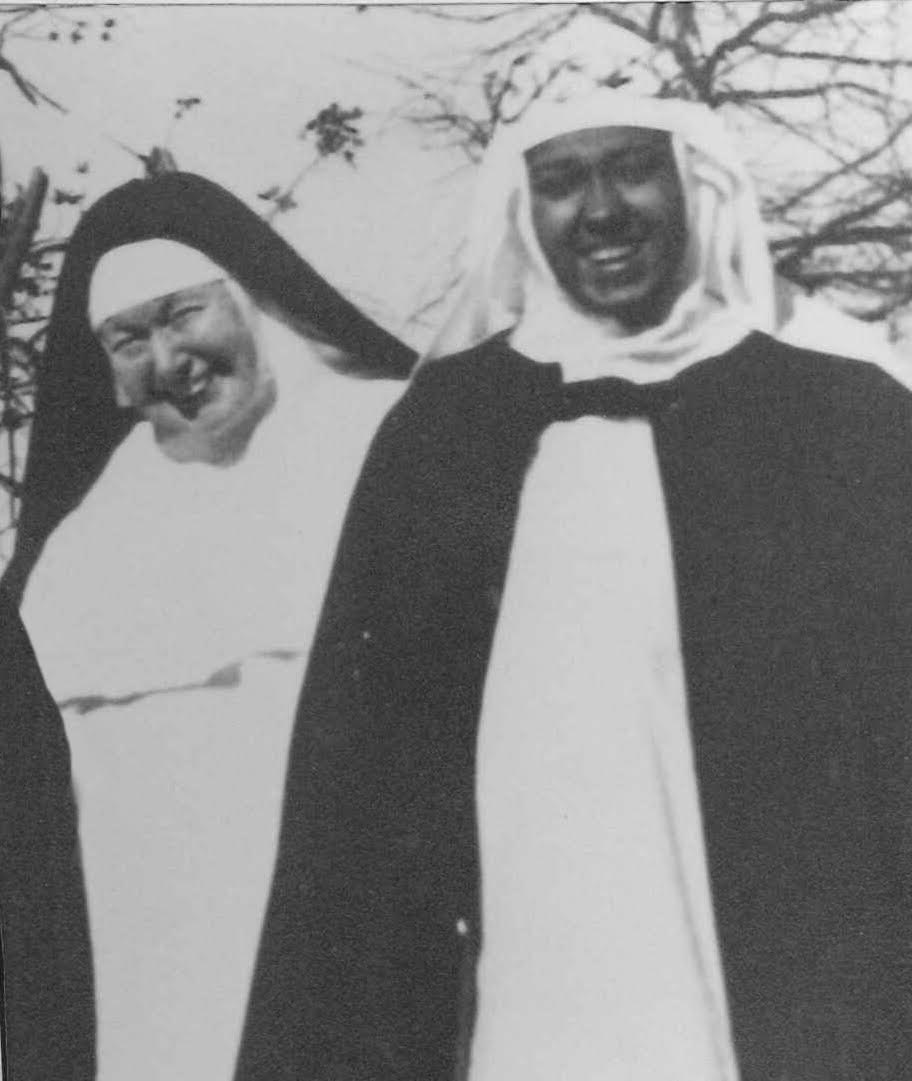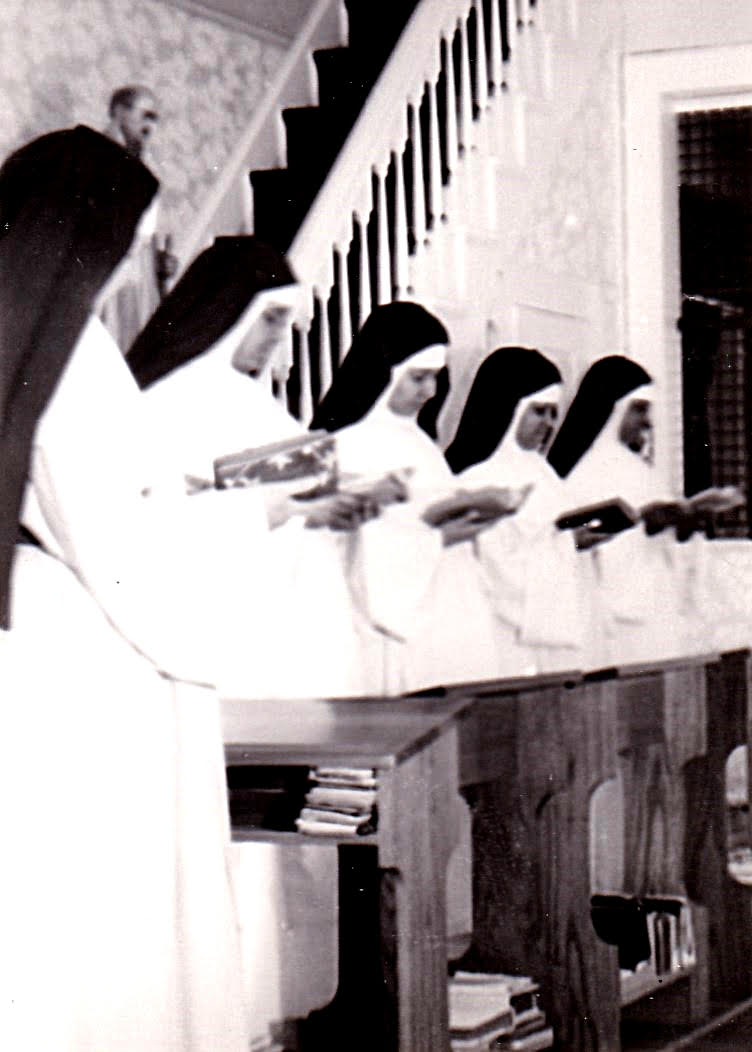One day, Mother Mary of Jesus, cloistered Dominican nun, had a vision. While in the monastery garden, she saw a scene of a race riot unfold before her. The sight was a violent one, with people of different races engaged in struggle.
Then Mother Mary of Jesus, who was white, saw a dark-skinned friar approaching the crowd. He was clad in the Dominican habit and holding a rosary. She recognized him as St. Martin de Porres. As Martin walked among the crowd, the weapons and clubs they were holding turned to rosaries and their fighting to prayer. Then Martin pointed to a monastery on the top of a hill. Mother Mary of Jesus saw there Dominican nuns of all races praying the Rosary, with their arms outstretched in the form of a cross.
In 1944, Mother Mary of Jesus and a couple of other women made a radical, counter-cultural decision to live transformative love. Their chosen means? They founded an integrated monastery of cloistered contemplative Dominican nuns.

At the time, their project to establish the first interracial monastery in the United States was contrary to segregation laws. However, from the outset, black and white sisters alike have lived side-by-side at the Dominican Monastery of St. Jude, sharing every chore, every moment of prayer, every sorrow, and every joy of community life.
Beginning a new foundation
Mother Mary of Jesus would not live to realize the vision she had seen. However, two nuns who were members of her monastery at Catonsville, Maryland, would. Mother Mary Dominic and Mother Mary of the Child Jesus wanted to open a monastery for those who desired God. But when a young African American woman inquired at Catonsville and was turned away because of her race, the sisters were galvanized to begin a new foundation.
The two Mothers received permission to write to bishops. They spent years writing letters, and received many responses. Some bishops offered initial favorable responses, but then the sisters would be turned down. Most admired their ideal, but thought it imprudent in their diocese at that time. After receiving permission to write just once more, the foundresses finally received a favorable reply from Archbishop Thomas Toolen of Mobile, Alabama.
With Archbishop Toolen’s support, the foundresses established the monastery in Marbury. Marbury was already home to a mission where the Resurrectionists were working to provide educational, medical, and spiritual services for African Americans. The nuns began their monastic contemplative life in the renovated farmhouse next door, the community numbering just the two foundresses and a postulant.
Marbury was a city set on a hill (Matt. 5:14). The monastery became a center where other religious sisters would visit and see a vibrant interracial community. Sr. Mary Jordan, the monastery’s current novice mistress, attests, “The bishop was proud of having a community like this in his diocese, and many priests and religious referred young women to the monastery.”

The invitation to love
A fundamental principle of the monastery’s foundation was to receive any suitable candidate seeking the contemplative life, regardless of her race. From its outset, then, the monastery preached by its founding intent: a vision of life where all would be invited to explore the depths of God’s love in monastic life. Sr. Mary Aimee recalls how the nuns’ charity touched the heart of a local Baptist workman during the construction of the new monastery in the 1950s:
One morning when the Mothers went up to go over plans with Mr. Brown, who was becoming more friendly with them, they found him in tears. “Why, Mr. Brown, what’s the matter?” they asked. “I feel so ashamed,” he said. “I’ve always been taught to hate Catholics, to think they were evil. And you people are so nice, you are always thinking of something to help us out.” “Well, that’s alright, Mr. Brown,” said Mother Mary of the Child Jesus. “But didn’t it ever occur to you that a preacher shouldn’t tell you to hate anybody, not if you’re going to be a Christian?” “No,” he said,“we didn’t think about it, we just accepted what they told us.”
God does not frustrate the desires he places on the heart
Sr. Mary Joseph, an African-American sister who joined the community in 1947, reflects on her own love for the Lord and the contemplative life. She says, “I don’t think God would have put this desire in my heart without a way to carry it out. I didn’t know what the ‘contemplative life’ was about, but I knew that I wanted to be a Sister but I didn’t want to teach or nurse. I had this desire for a life of prayer, singing praise to God, and complete dedication to Him.” As an interracial foundation, Marbury was the place the Lord intended for Sr. Mary Joseph’s desire to blossom. The authentic love she experienced from her very first meeting with Mother Mary Dominic has continued to mark her life in the monastery to this day.
Building a culture of transformative love
Life in the monastery is a marketplace of love. But how is that possible? How do the sisters live transformative love? Sr. Mary Jordan says, “The fact that we have come to the monastery to live one mind and one heart in the Lord means that when emotional challenges and personal difficulties come we have a groundwork to move forward in the context of our community.” Knowing that each sister is valued, concern for all is manifest.

That’s not to say that there are never disagreements. Quoting the proverb, A gentle answer turns away wrath. (Prov 15:1), Sr. Mary Jordan noted, “If you want to have a fight with someone, whether they’re being provocative or even just tired, respond in kind.” Instead, whether inside or outside the monastery, the response of gentleness and understanding allows community life to heal and flourish. Sr. Mary Jordan says, “Our way of life encourages taking responsibility, admitting one’s faults, and asking for and receiving forgiveness.”
The monastery witnesses to a culture of love. The custom book of Marbury says that the sisters are to be “other Marys,” witnessing Christ to each other. As Mother Mary of the Precious Blood attests, “Whatever their race, the Sisters are united in their identity as Dominicans, as Spouses of Christ giving themselves to Him through the monastic silence, the chant of the liturgy, the praying of the Rosary, and zeal for the salvation of souls.”
At Marbury, Mother Mary Dominic never spoke of blacks and whites. When the two foundresses died, the next leader of the monastery was an African American sister. Her election was not predicated on race. She was simply the best candidate to lead the community. The culture of the monastery was such that race wasn’t an issue. The monastery has its own culture, albeit one that may seem far from the experience of many young women today. Concerning the question of new vocations, Sr. Mary Jordan suggests, “Today, race isn’t as much a challenge as the prevailing popular culture.”
The gift of self
In the end, as John Paul II says, “Love causes man to find fulfillment through the sincere gift of self. To love means to give and to receive something which can be neither bought nor sold, but only given freely and mutually.” The monastery sheds light on the civilization of love because the nuns at Marbury are given to God, and therefore given to each other. As the monastery’s Constitutions say, “The unanimity of our life, rooted in the love of God, should furnish a living example of that reconciliation of all things in Christ …” For men and women of every race and tongue, only the gift of self sheds light and meaning on our existence. As the Second Vatican Council says, “Man cannot fully find himself except through a sincere gift of self.”








